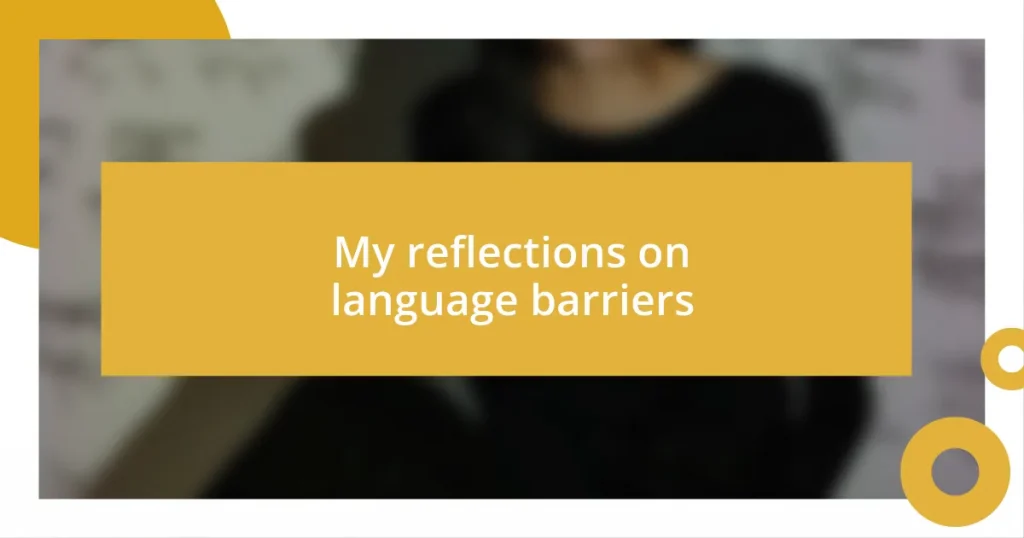Key takeaways:
- Language barriers reveal the emotional challenges of communication, leading to feelings of isolation and misunderstandings.
- Effective strategies to overcome language barriers include adapting language use, utilizing translation technology, and engaging in cultural immersion.
- Cultural sensitivity is crucial for fostering meaningful connections, requiring awareness of non-verbal cues and an openness to learn from others.
- Humor can be a powerful tool in cross-cultural communication, breaking down barriers and building camaraderie among diverse groups.
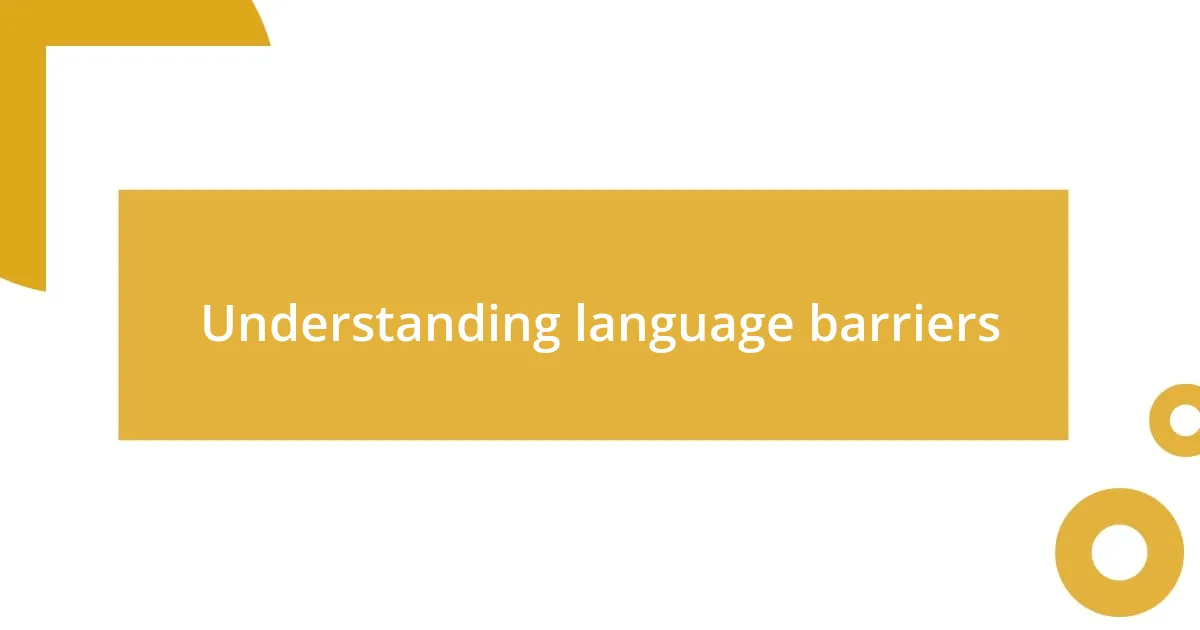
Understanding language barriers
Language barriers can feel like a daunting wall, can’t they? I remember a time when I tried to communicate during my travels in a region where English wasn’t widely spoken. The frustration was palpable, but what struck me most was the realization of how much is lost in translation—words, emotions, and even intentions.
In my experience, language serves not merely as a tool for communication but as a bridge to understanding cultures. One incident has stuck with me: a friend of mine, who was learning Spanish, attempted to make a joke. The punchline missed its mark because the nuance didn’t translate. We all laughed anyway, but it highlighted the delicate dance of meaning that accompanies every conversation, especially across different languages. Have you ever found yourself in a similar situation where understanding felt just out of reach?
Often, the emotional weight of not being understood can lead to feelings of isolation. I recall a poignant moment at a multicultural gathering where some, despite being in a room full of people, felt completely alone due to language differences. It made me reflect on how vital it is to foster environments where everyone feels they can contribute, regardless of their linguistic abilities.
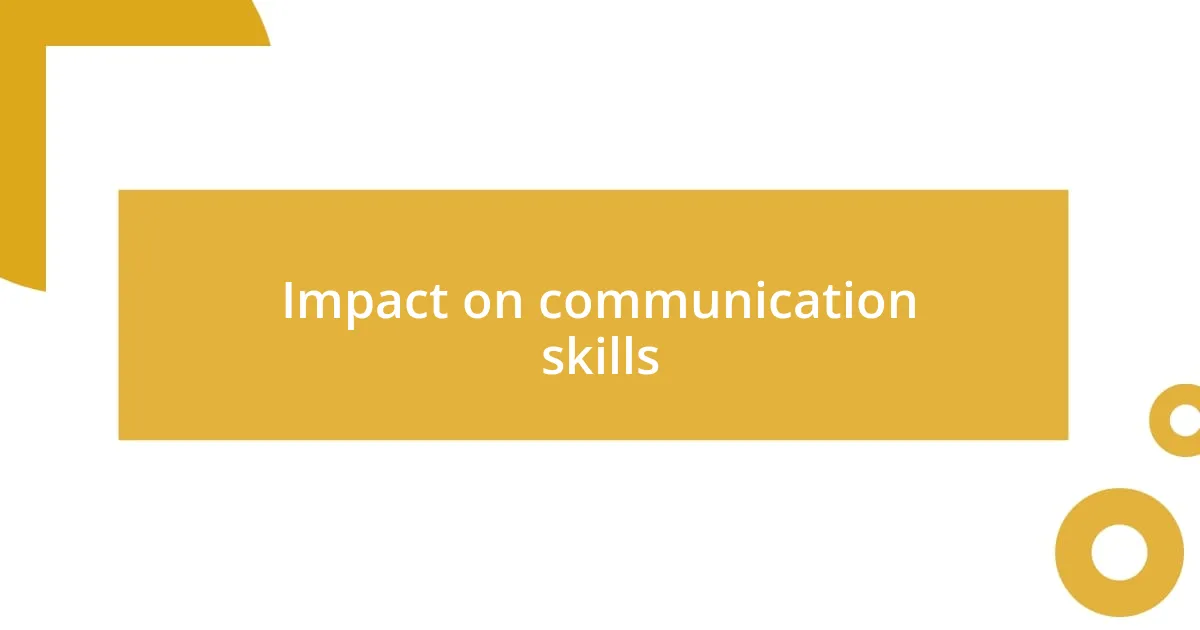
Impact on communication skills
Navigating language barriers can significantly hinder effective communication skills. I recall attending a meeting where someone attempted to express a complex idea in English, but their struggles with vocabulary led to confusion among the team. The entire discussion devolved into misinterpretations, emphasizing how essential clarity and shared understanding are in fostering collaborative environments.
- Increased stress levels due to miscommunication.
- Missed opportunities for expressing creativity or ideas.
- Reduced confidence in speaking up, especially in group settings.
- Difficulty forming professional networks or friendships.
- Reliance on non-verbal cues can lead to misunderstandings.
Every interaction becomes a tightrope walk, balancing words and gestures, which is emotionally taxing. I’ve come to believe that honing our communication skills to bridge these gaps not only fosters connection but is also a crucial step in personal and professional growth.
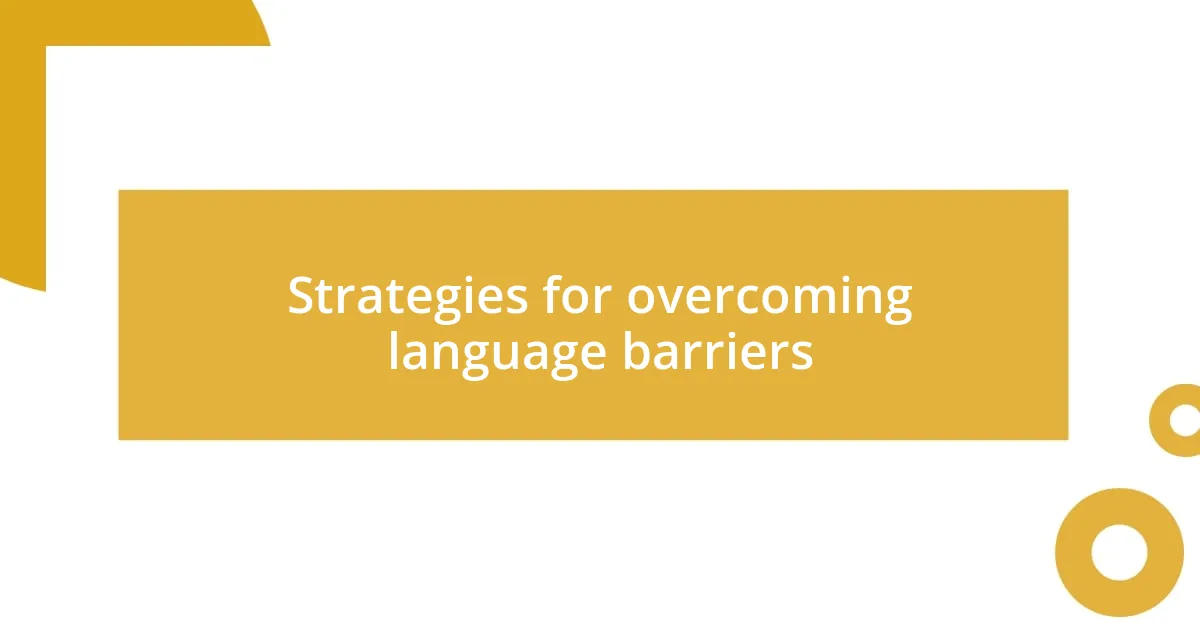
Strategies for overcoming language barriers
Overcoming language barriers often starts with a willingness to adapt and learn. I remember attending a workshop where we were encouraged to use simple language and confirm understanding. It was a humbling experience to see how effective this approach could be, creating an atmosphere of inclusivity and shared learning. It made me realize that being patient and encouraging questions can break down walls that often feel insurmountable.
Another powerful strategy involves embracing technology. During a team project, I frequently relied on translation apps to bridge the gap with a colleague who spoke limited English. While not perfect, these tools provided immediate assistance and fostered a sense of teamwork that transcended our linguistic differences. It’s fascinating how a simple app can empower us to connect and collaborate seamlessly.
Lastly, cultural immersion is key. I participated in a language exchange program where natives of different languages paired up to practice speaking. My partner’s enthusiasm and willingness to share their culture made the experience enjoyable and educational. I can vividly recall how small gestures, like sharing traditional phrases, brought us closer together, creating a bond that no language barrier could break.
| Strategy | Description |
|---|---|
| Adaptation and Patience | Using simple language and confirming understanding fosters inclusivity. |
| Technology Utilization | Translation apps can bridge gaps and enhance collaboration. |
| Cultural Immersion | Language exchanges promote connection through shared experiences. |

Role of technology in translation
The role of technology in translation is undeniably transformative. I remember using a translation app during a group vacation abroad; it felt like a breakthrough moment when I could finally ask for directions without fumbling through multiple languages. Wasn’t it empowering to have that instant communication tool at my fingertips? Technology removed the discomfort of not understanding, allowing us to explore freely and engage with locals in ways that would have been impossible otherwise.
In professional settings, I’ve seen how tools like Google Translate can instantly turn a daunting task into something manageable. I once participated in a multinational conference where speakers presented in various languages. The live translation feature on our devices didn’t just facilitate comprehension; it sparked genuine conversations and networking opportunities. It makes me wonder: without such technological advancements, how would we ever connect across cultures?
It’s intriguing to see how technology fosters not just understanding, but also emotional connections. During a virtual language exchange, I utilized real-time translation tools to break down initial barriers. As we joked and shared stories, I felt that my ability to communicate grew in both language and heart. Isn’t it remarkable how technology can bridge gaps and create bonds that transcend mere words?
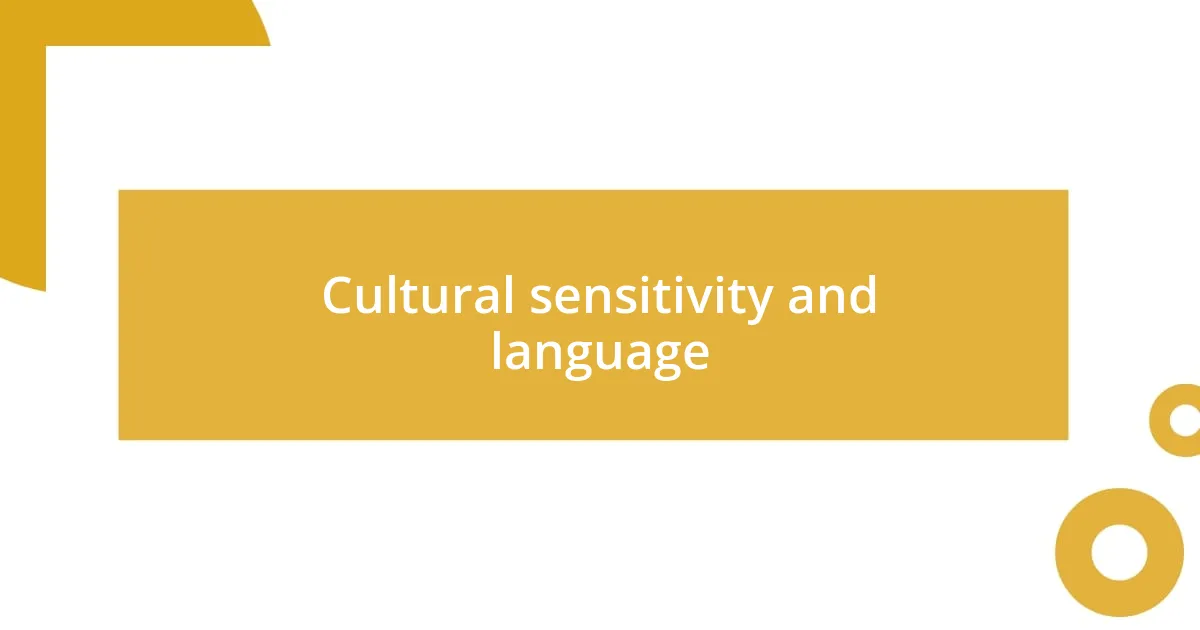
Cultural sensitivity and language
Cultural sensitivity plays a crucial role when navigating language differences. I recall my first experience at an international dinner, where the table was filled with people from varied backgrounds. As we shared dishes from our cultures, I quickly learned to appreciate how much food and language overlap, each dish telling a story. It struck me how taking the time to understand others’ traditions and communication styles not only enriched my experience but also made the environment more welcoming.
Engaging with people in a culturally sensitive manner often means being aware of non-verbal cues. I remember chatting with a colleague from Japan, where the nuances of polite conversation are vastly different. While I could speak the words, I had to pay close attention to their body language and pauses. It was like deciphering a code; sometimes, what was left unsaid was just as important as the words spoken. Reflecting on this, I realized cultural sensitivity is about more than just language; it’s about listening deeply and honoring the silence that often carries meaning.
I find that being culturally sensitive encourages me to step out of my comfort zone and ask questions, even when I feel hesitant. Prepping for a presentation in a multicultural setting, I reached out to team members from different backgrounds and asked for their input. The insights they offered were invaluable and transformed my understanding of the topic. Have you ever wondered how much richer your perspective could be by simply leaning into those conversations? Embracing cultural sensitivity in our language interactions can truly lead to deeper connections and mutual respect.

Personal experiences with language barriers
While traveling through a small town in Spain, I faced a real language barrier. I attempted to order a meal with limited Spanish vocabulary, and the waiter’s puzzled expression made my heart race. It was both embarrassing and a little humorous when I ended up with a completely different dish than I intended. In that moment, I realized how practicing language could transcend the mere act of speaking; it ignited a determination in me to learn and connect.
On another occasion, during a business meeting with a partner from Brazil, I encountered the nuances of unspoken language. Though we both spoke English, I noticed that certain phrases didn’t translate well and led to misunderstandings. I’ll never forget the moment when a simple smile or nod made us both laugh, easing the tension. It made me appreciate how much meaning we can convey through body language, facial expressions, and even silence. Have you ever felt that connection when words just didn’t seem enough?
Reflecting on my experiences, I’ve come to understand that each language barrier I faced taught me patience and empathy. During a volunteer project, I had to communicate with children who spoke no English. I found myself using gestures and drawing pictures to connect, and it was incredibly fulfilling to see their faces light up when they understood. It reminds me that communication goes far beyond words; it’s about the genuine effort to connect and share moments that make us human. Isn’t it incredible how our struggles with language can lead to the richest interactions?

Tips for effective cross-cultural communication
Effective cross-cultural communication often starts with an open mind and a willingness to adapt. I remember a time at a multinational conference where the presentations were in multiple languages. Instead of feeling overwhelmed, I took notes in both English and the local language. This approach not only helped me grasp the content but also showed my colleagues that I valued their efforts. Have you ever tried to meet someone halfway—didn’t it create a sense of camaraderie?
Listening actively is another essential tip I’ve found invaluable. During a brainstorming session with a diverse team, I made a conscious effort to really focus on each participant’s input. I noticed that by asking follow-up questions and seeking clarification, the conversation flowed more naturally. It always amazes me how a simple pause combined with a nod can convey understanding, making everyone feel seen and heard. Have you noticed how much more engaged people become when they feel their contributions matter?
Lastly, embracing humor can break down barriers in cross-cultural settings. I vividly recall a workshop where language misinterpretations led to some hilarious situations. Instead of shying away, we laughed about our mix-ups, making the atmosphere light-hearted. This experience showed me that humor is a universal language, capable of bridging gaps and creating connections. Isn’t it empowering to recognize that even in our differences, we can find common ground through a shared laugh?










